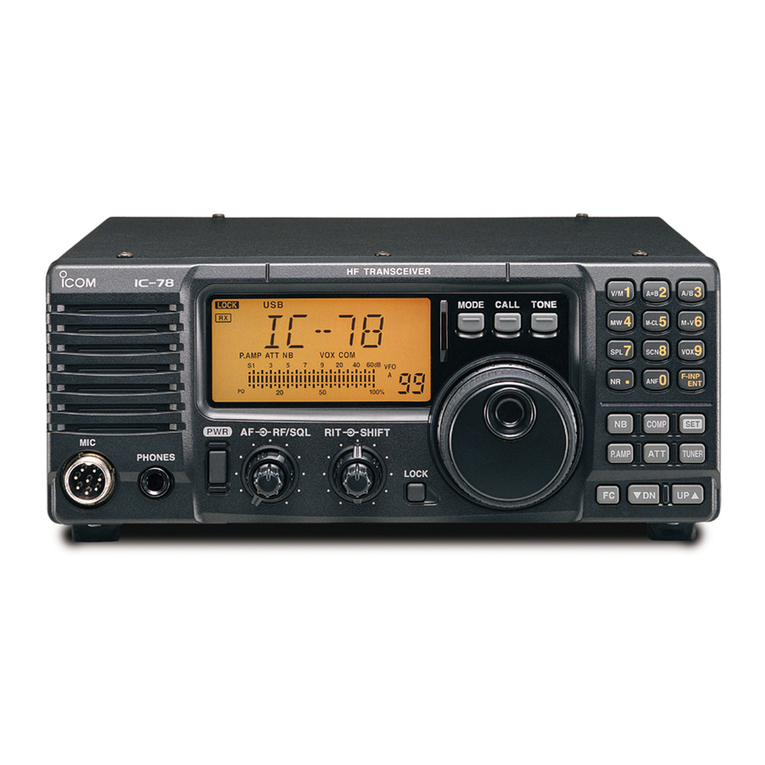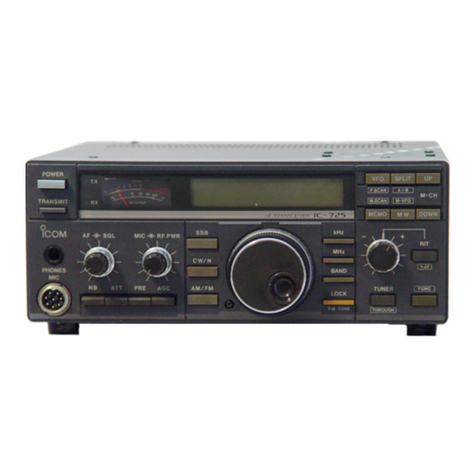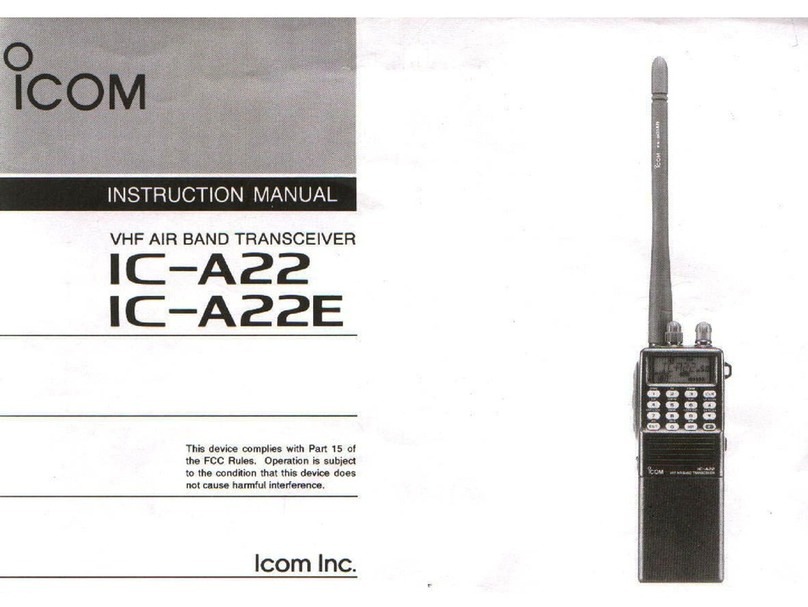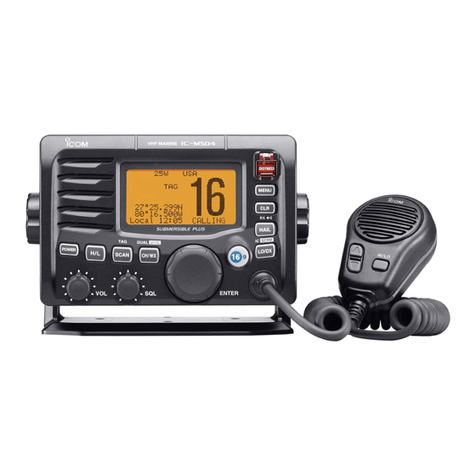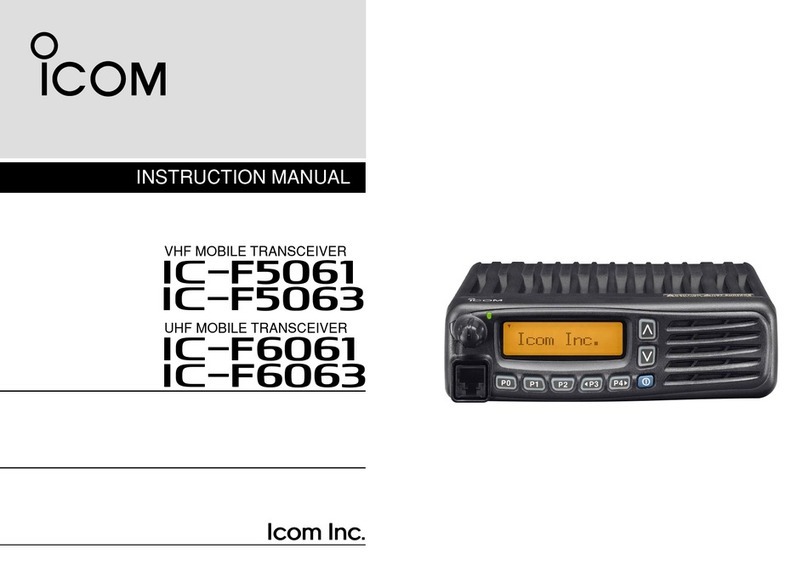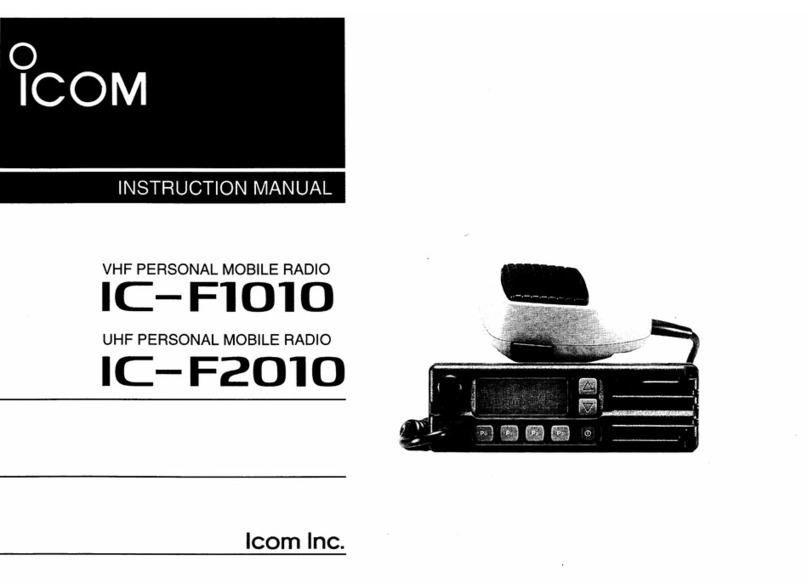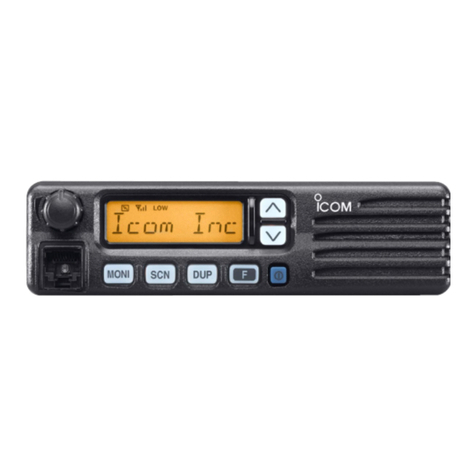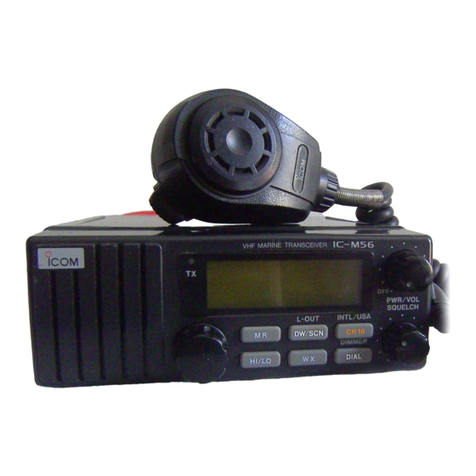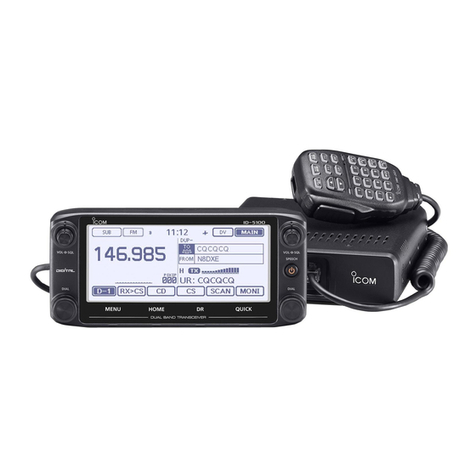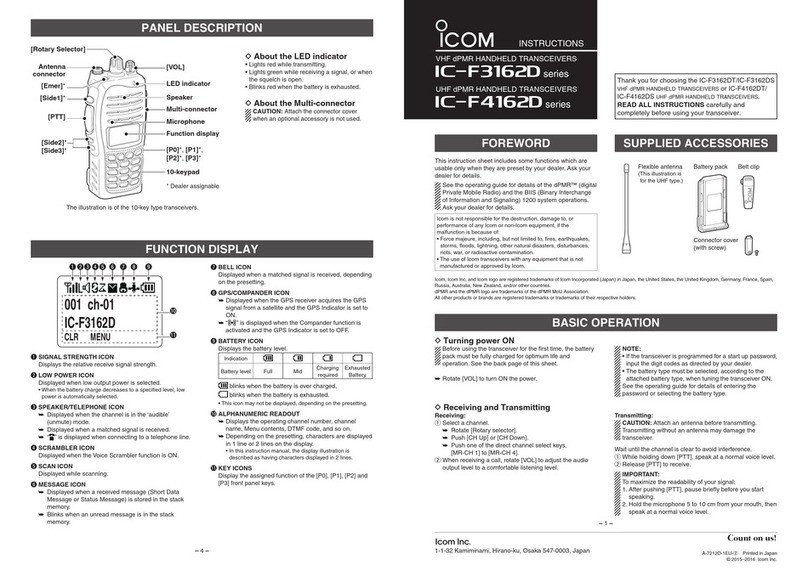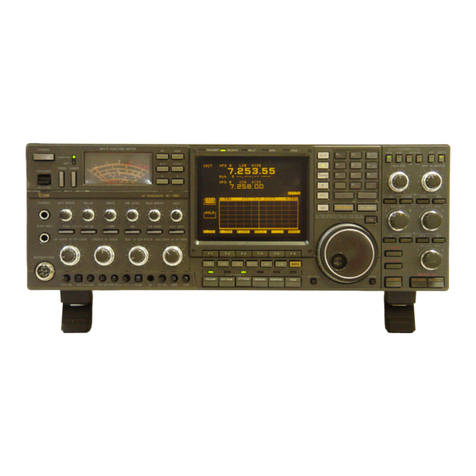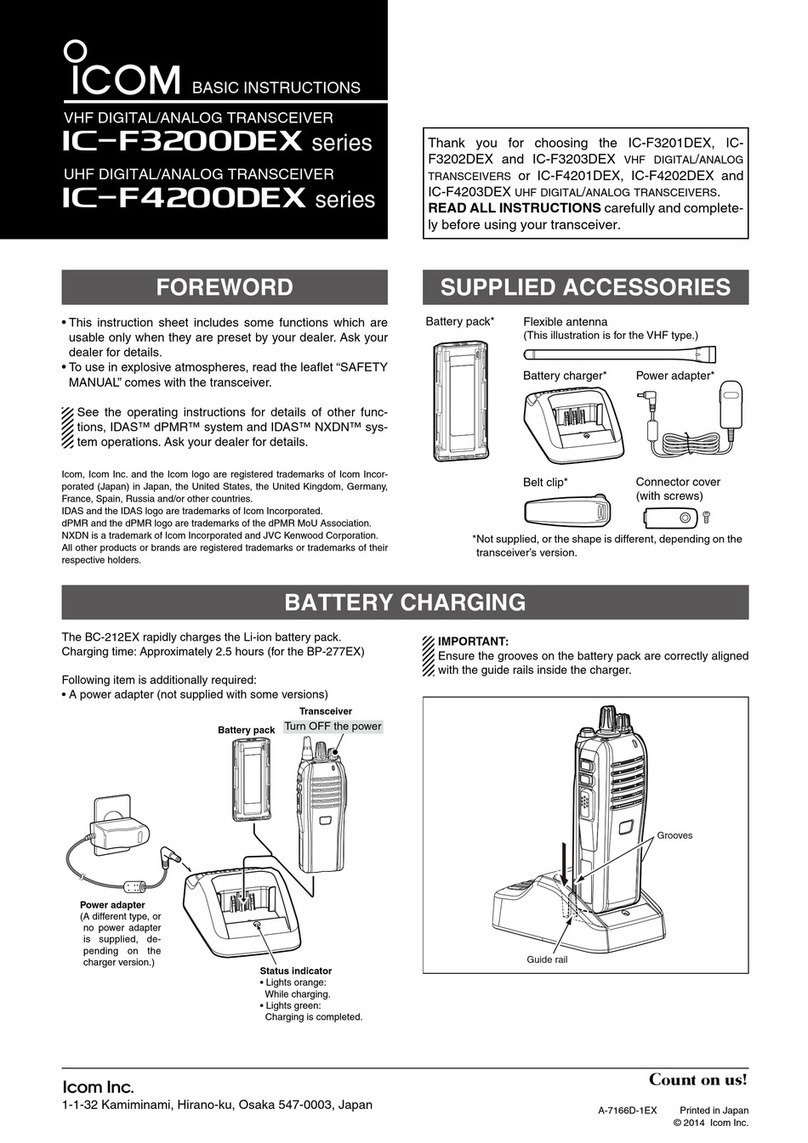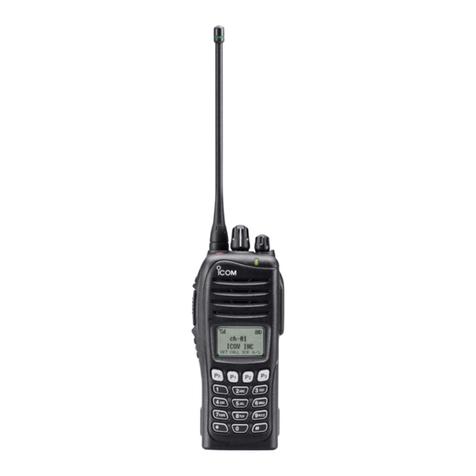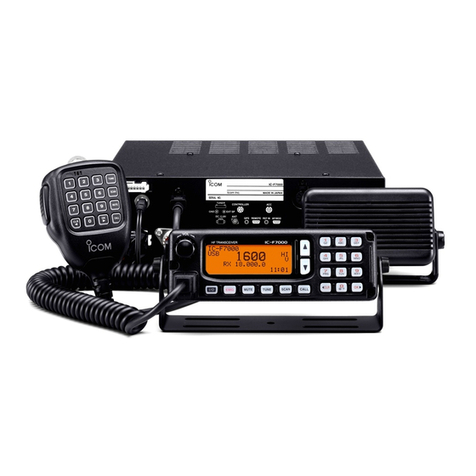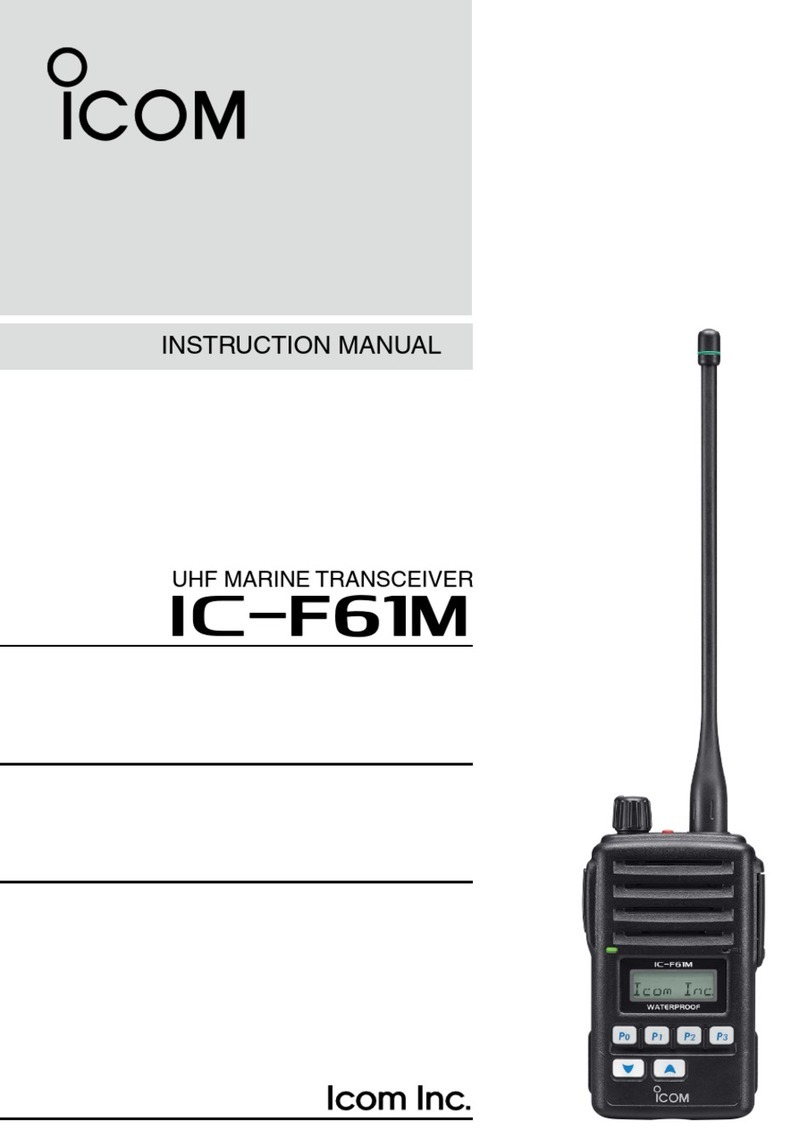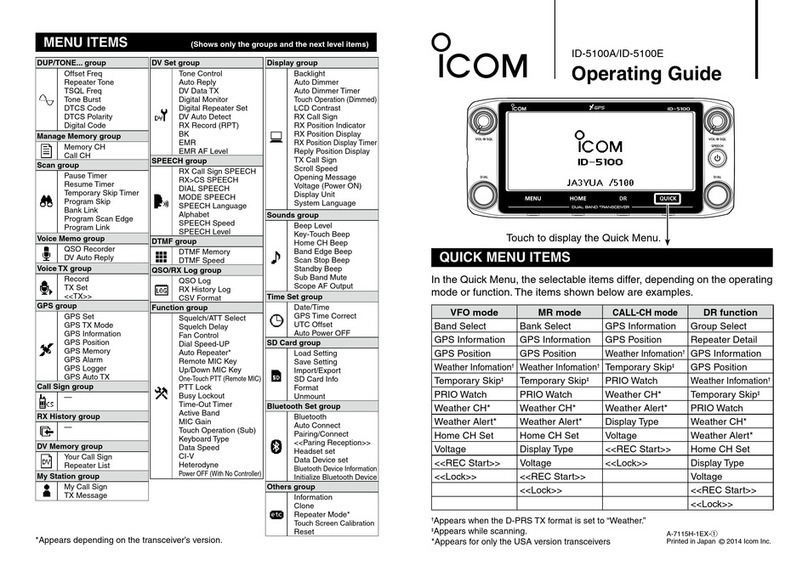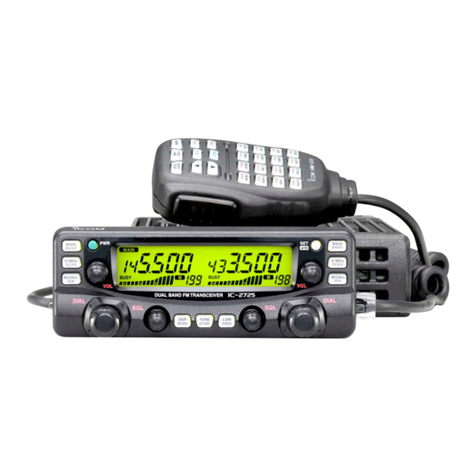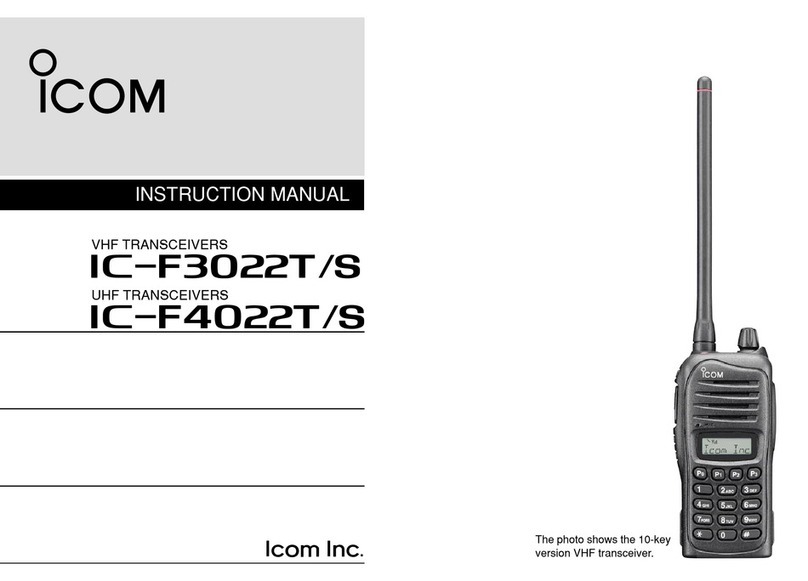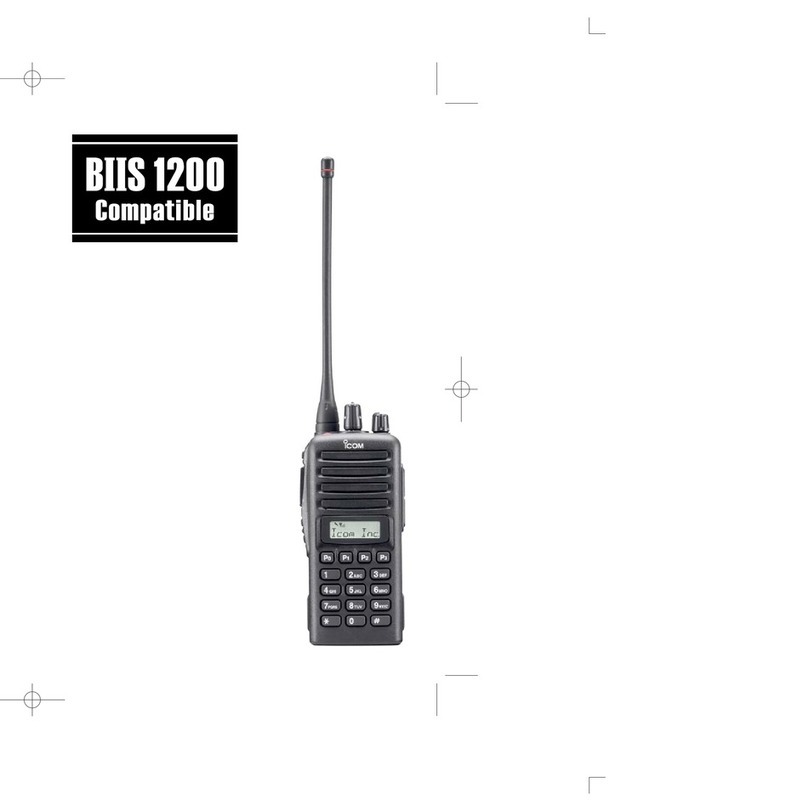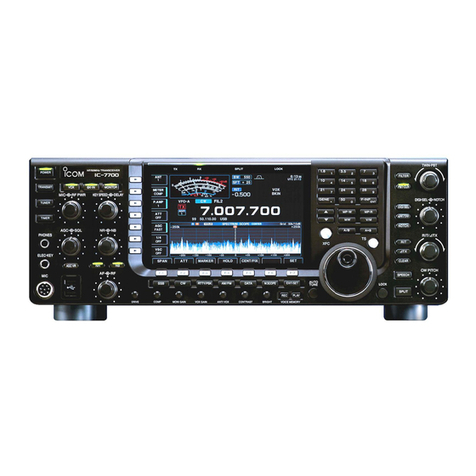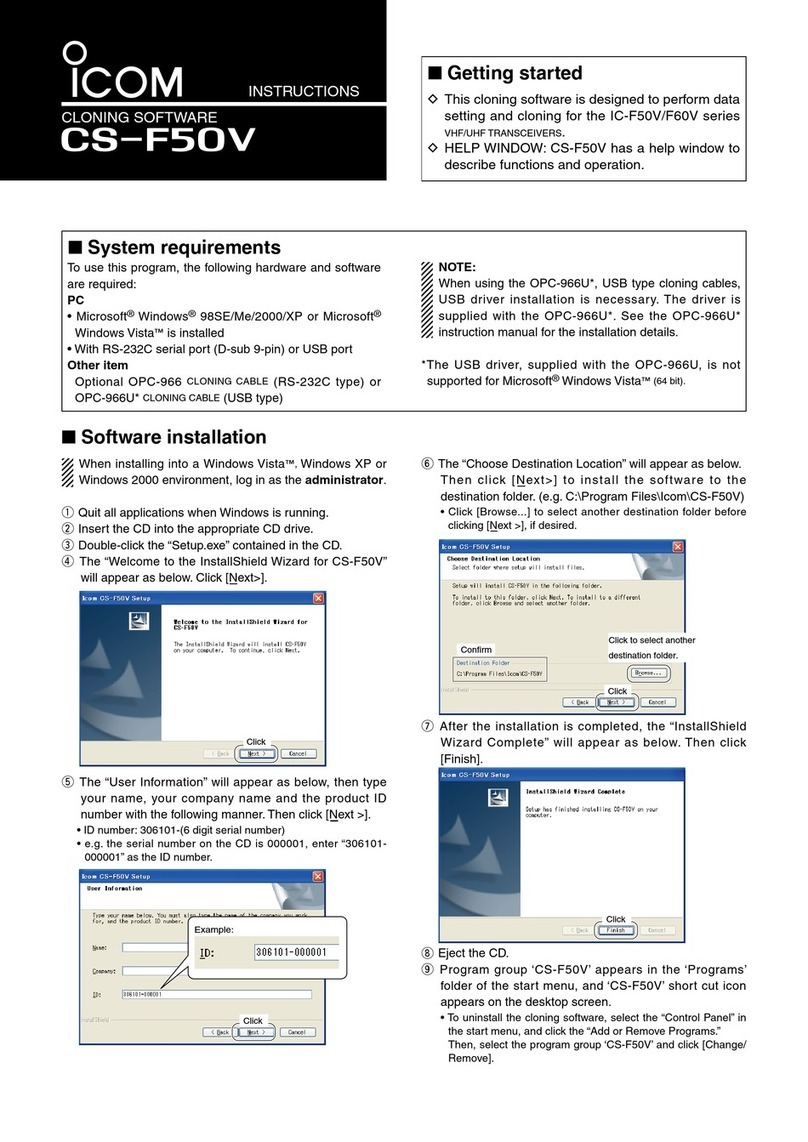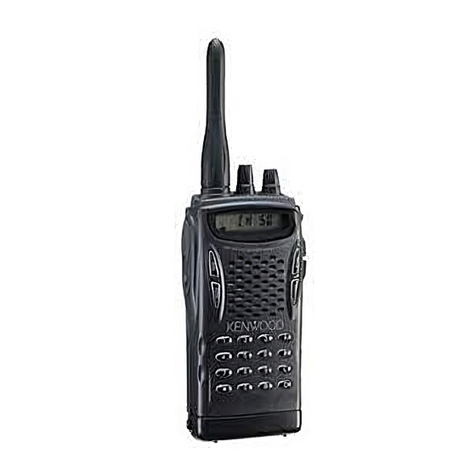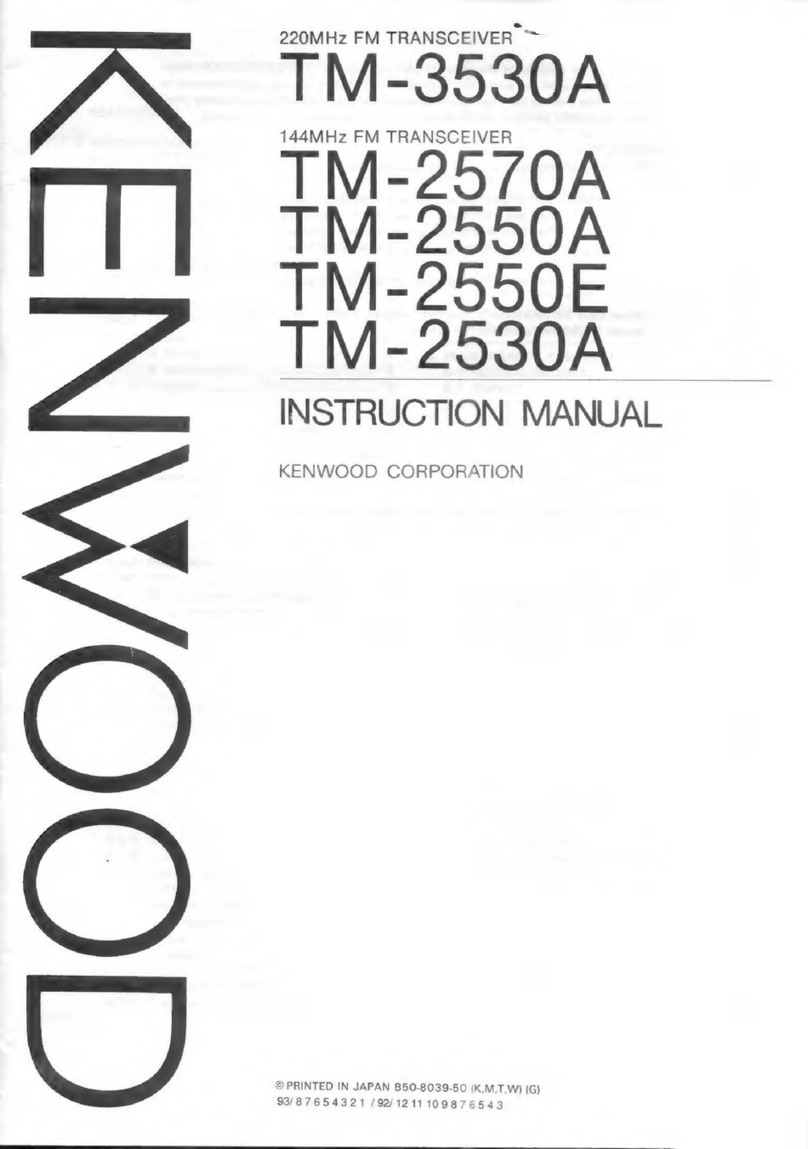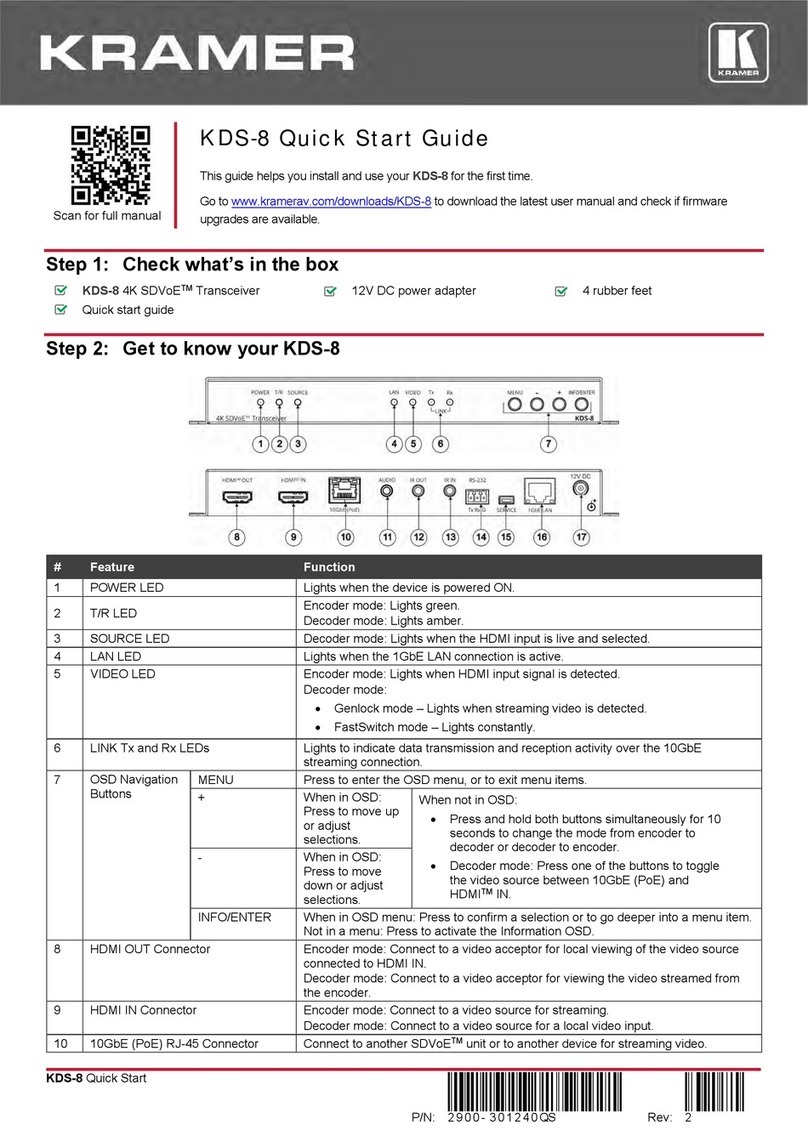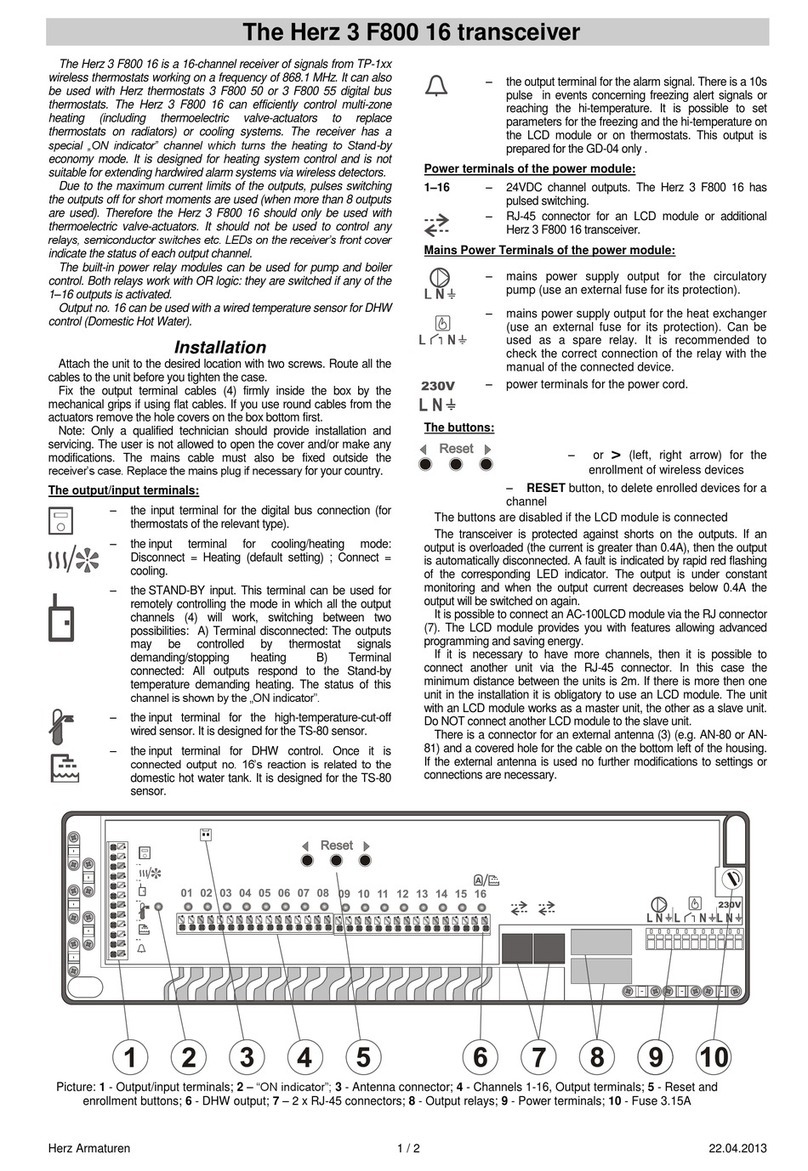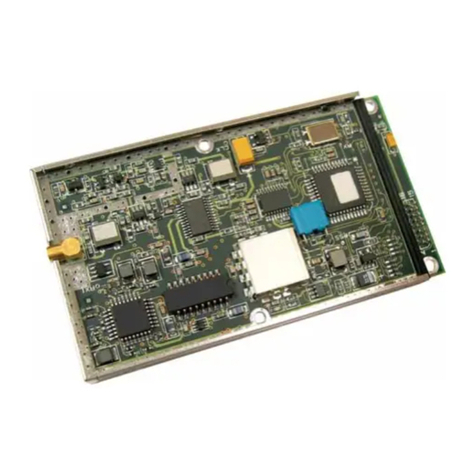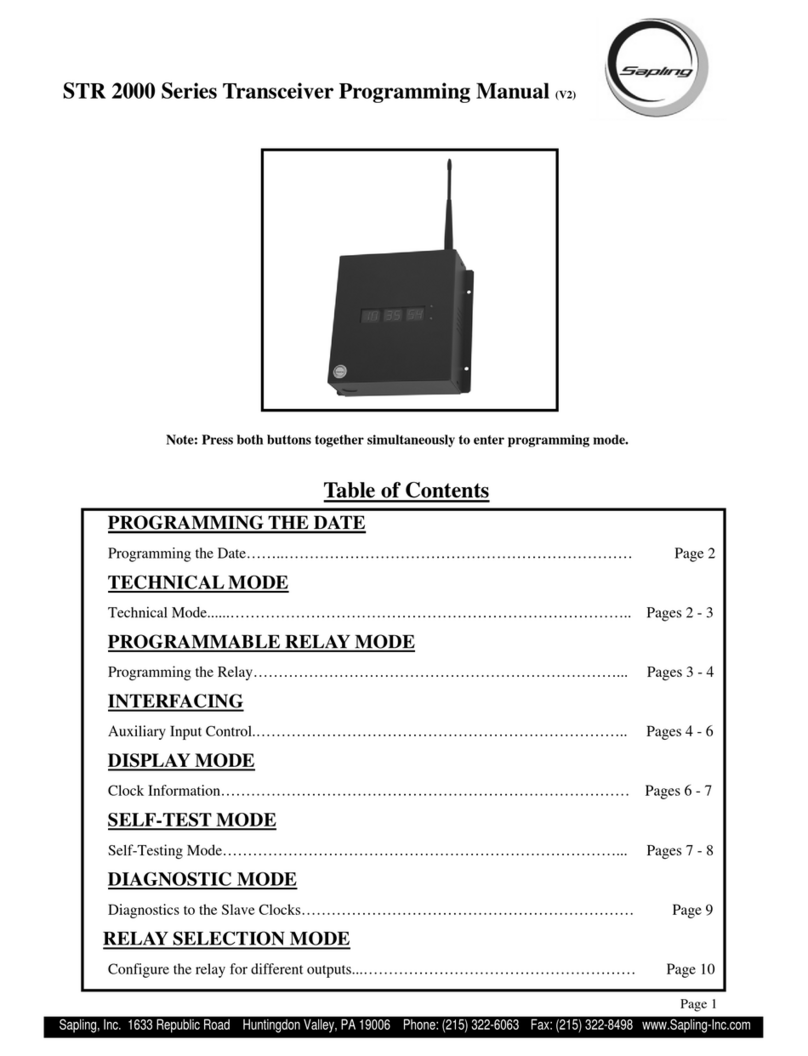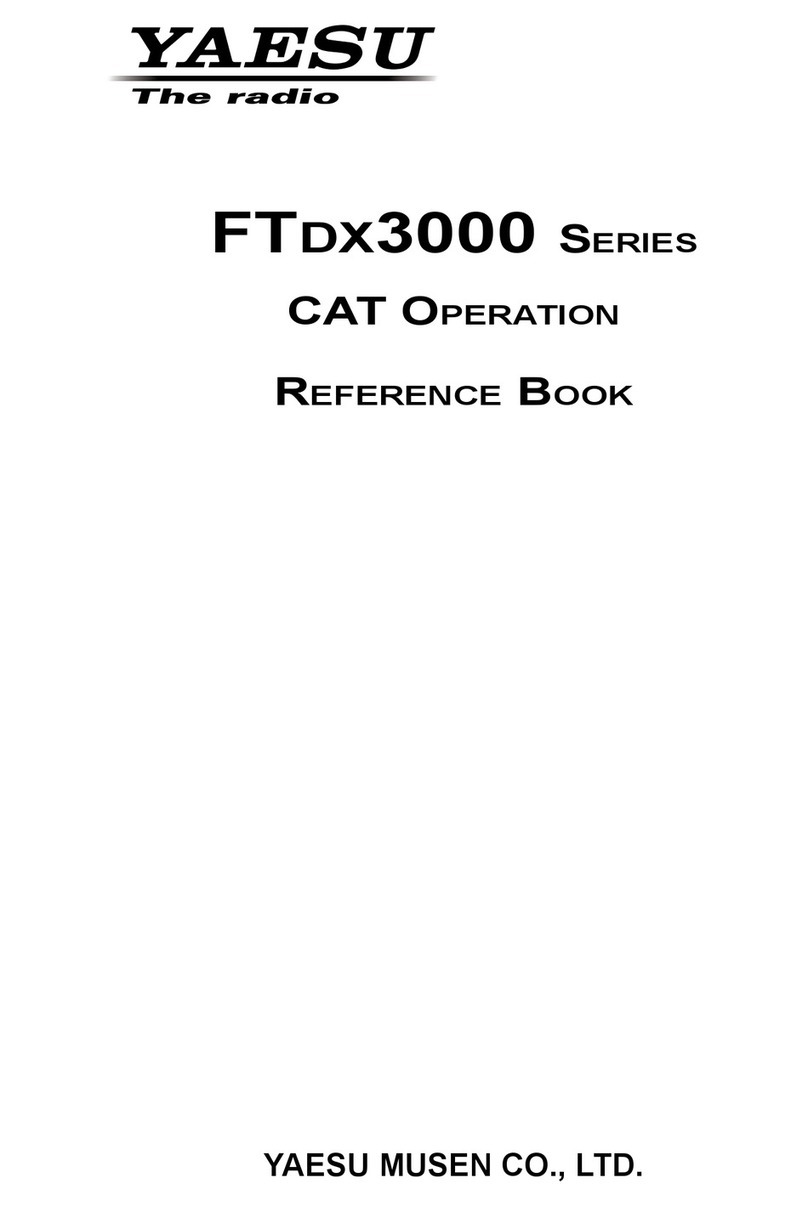Icom VHF MARINE TRANSCEIVER IC-M501EURO User manual

INSTRUCTION MANUAL
iM501EURO
VHF MARINE TRANSCEIVER
0 IC-M501EURO_3.qxd 03.7.29 15:26 Page a

If your vessel requires assistance, contact other vessels and
the Coast Guard by sending a distress call on channel 16.
Or, transmit your distress call using digital selective calling on
channel 70 (the optional DS-100 must be installed).
USING DIGITAL SELECTIVE CALLING (ch 70)
(DS-100 DSC CONTROLLER is required)
DISTRESS CALL PROCEDURE
1. Push and hold [DISTRESS] on the DS-100
for 5 sec. until you hear 5 short beeps
change to one long beep.
2. Wait for an acknowledgment from a coast
station.
• Channel 16 is automatically selected.
3. Push and hold [PTT], then transmit the
appropriate information as at left.
USING CHANNEL 16
DISTRESS CALL PROCEDURE
1. “MAYDAY MAYDAY MAYDAY.”
2. “THIS IS ...............” (name of vessel)
3. Your call sign or other indication of the
vessel (AND 9-digit DSC ID if you have one).
4. “LOCATED AT ...............” (your position)
5. The nature of the distress and assistance
required.
6. Any other information which might facilitate
the rescue.
IN CASE OF EMERGENCY
i
Versions of the IC-M501EURO which display the “CE” symbol on the serial number seal, comply with the es-
sential requirements of the European Radio and Telecommunication Terminal Directive 1999/5/EC. òThis
warning symbol indicates that this equipment operates in non-harmonised frequency bands and/or may be sub-
ject to licensing conditions in the country of use. Be sure to check that you have the correct version of this radio
or the correct programming of this radio, to comply with national licensing requirement.
0 IC-M501EURO_3.qxd 03.7.29 15:26 Page b

ii
TABLE OF CONTENTS
INSTALLATION NOTES
The installation of this equipment should be
made in such a manner as to respect the EC
recommended electromagnetic field expo-
sure limits (1999/519/EC).
The maximum RF power available from this
device is 25 watts. The antenna should be
installed as high as possible for maximum ef-
ficiency and that this installation height
should be at least 5 meters above ground (or
accessible) level. In the case where an an-
tenna cannot be installed at a reasonable
height, then the transmitter should neither be
continuously operated for long periods if any
person is within 5 meters of the antenna, nor
operated at all if any person is touching the
antenna.
In all cases any possible risk depends on the
transmitter being activated for long periods.
(actual recommendation limits are specified
as an average of 6 minutes) Normally the
transmitter is not active for long periods of
time. Some radio licenses will require that a
timer circuit automatically cuts the transmit-
ter after 1–2 minutes etc.
Similarly some types of transmitter, SSB,
CW, AM, etc. have a lower ‘average’ output
power and the perceived risk is even lower.
1 OPERATING RULES .......................... 1
2 PANEL DESCRIPTION .................. 2 – 5
■ Panel description ............................. 2
■ Function display ............................... 4
■ Microphone ...................................... 5
3 BASIC OPERATION .................... 6 – 10
■ Channel selection ............................ 6
■ Receiving and transmitting .............. 8
■ Call channel programming ............... 9
■ Channel names ................................ 9
■
Optional voice scrambler operation
.. 10
4 DUALWATCH/TRI-WATCH ............... 11
■ Description ..................................... 11
■ Operation ....................................... 11
5 SCAN OPERATIONS ................. 12 – 13
■ Scan types ..................................... 12
■ Setting tag channels ...................... 13
■ Starting a scan ............................... 13
6 SET MODE ................................. 14 – 16
■ Set mode programming ................. 14
■ Set mode items .............................. 15
7 CONNECTIONS AND
MAINTENANCE ......................... 17 – 22
■ Unpacking ...................................... 17
■ Antenna ......................................... 17
■ Fuse replacement .......................... 17
■ Cleaning ......................................... 17
■ Connections ................................... 18
■ Mounting the transceiver ............... 19
■ Optional unit installation ................. 21
■ Dimensions ..................................... 20
8 TROUBLESHOOTING ...................... 23
9 CHANNEL LIST ................................ 24
10 SPECIFICATIONS AND OPTIONS ... 25
■ Specifications ................................. 25
■ Options .......................................... 25
MB-75 TEMPLATE
0 IC-M501EURO_3.qxd 03.7.29 15:26 Page c

iii
READ ALL INSTRUCTIONS carefully and completely
before using the transceiver.
SAVE THIS INSTRUCTION MANUAL —This in-
struction manual contains important operating instructions for
the IC-M501EURO.
RWARNING! NEVER connect the transceiver to an AC
outlet. This may pose a fire hazard or result in an electric
shock.
NEVER connect the transceiver to a power source of more
than 16 V DC or using reverse polarity. This will ruin the trans-
ceiver.
NEVER cut the DC power cable between the DC plug and
fuse holder. If an incorrect connection is made after cutting,
the transceiver may be damaged.
NEVER place the transceiver where normal operation of the
vehicle may be hindered or where it could cause bodily injury.
KEEP the transceiver at least 3.3 ft (1 m) away from the
ship’s navigation compass.
DO NOT use or place the transceiver in areas with temper-
atures below –4°F (–20°C) or above +140°F (+60°C) or, in
areas subject to direct sunlight, such as the dashboard.
AVOID the use of chemical agents such as benzine or al-
cohol when cleaning, as they may damage the transceiver
surfaces.
BE CAREFUL! The transceiver rear panel will become
hot when operating continuously for long periods.
Place the transceiver in a secure place to avoid inadvertent
use by children.
After exposure to water including fresh water, clean the trans-
ceiver thoroughly with fresh water to avoid corrosion.
CAUTIONS
IMPORTANT
0 IC-M501EURO_3.qxd 03.7.29 15:26 Page d

1
1
OPERATING RULES
◊PRIORITIES
•Read all rules and regulations pertaining to priorities and
keep an up-to-date copy handy. Safety and distress calls
take priority over all others.
• You must monitor channel 16 when you are not operating on
another channel.
•False or fraudulent distress signals are prohibited and pun-
ishable by law.
◊PRIVACY
•Information overheard but not intended for you cannot law-
fully be used in any way.
• Indecent or profane language is prohibited.
◊RADIO LICENSES
(1) SHIP STATION LICENSE
You must have a current radio station license before using the
transceiver. It is unlawful to operate a ship station which is not
licensed.
Inquire through your dealer or the appropriate government
agency for a Ship-Radiotelephone license application. This
government-issued license states the call sign which is your
craft’s identification for radio purposes.
(2) OPERATOR’S LICENSE
A Restricted Radiotelephone Operator Permit is the license
most often held by small vessel radio operators when a radio
is not required for safety purposes.
The Restricted Radiotelephone Operator Permit must be
posted or kept with the operator. Only a licensed radio opera-
tor may operate a transceiver.
However, non-licensed individuals may talk over a transceiver
if a licensed operator starts, supervises, ends the call and
makes the necessary log entries.
Keep a copy of the current government rules and regulations
handy.
0 IC-M501EURO_3.qxd 03.7.29 15:26 Page 1

PANEL DESCRIPTION
2
2
■Panel description
CALLDUAL SCAN
WATER RESISTANT
TAG DIAL
DIMMER
HI/LO
POWER
VOL
iM501EURO
VHF MARINE
SQL
16
Speaker
Function
display
q
werty u
io!0!1
qPOWER SWITCH [POWER]
Push to toggle the transceiver power ON and OFF.
wVOLUME CONTROL [VOL]
Adjusts the audio level. (p. 8)
eSQUELCH CONTROL [SQL]
Sets the squelch threshold level. (p. 8)
rTRANSMIT POWER SWITCH [HI/LO]
➥Toggles high and low power when pushed. (p. 8)
•Some channels are set to low power only.
➥While pushing this switch, other switches perform sec-
ondary functions.
0 IC-M501EURO_3.qxd 03.7.29 15:26 Page 2

tCHANNEL SELECTOR [CHANNEL]
Rotate [CHANNEL] to select the operating channels, set
mode contents, etc. (p. 8)
yDIMMER SWITCH [DIMMER]
Push to select one of 8 backlighting (LCD and switches)
levels.
uCALL CHANNEL SWITCH [CALL]
➥Push to select the call channel. (p. 6)
➥Push for 3 sec. to enter call channel programming con-
dition. (p. 9)
➥While pushing [HI/LO], enters memory name program-
ming condition. (p. 9)
iCHANNEL 16 SWITCH [16]
➥Selects channel 16 when pushed. (p. 6)
➥Enters initial set mode when pushed while turning power
ON. (p. 14)
oDIAL SWITCH [DIAL]
➥Exits from channel 16 or call channel when pushed. (p.
6)
➥While pushing [HI/LO], selects channel group when
pushed. (pgs. 6, 7)
•The European version has International channels only and
this function is not available.
!0 SCAN SWITCH [SCAN/TAG] (p. 13)
➥Starts and stops normal or priority scan when tag chan-
nels are programmed.
➥Push [SCAN/TAG] for 1 sec. to set the displayed chan-
nel as a tag (scanned) channel.
➥While pushing [HI/LO], push for 3 sec. to clear all tag
channels.
!1 DUALWATCH/TRI-WATCH SWITCH [DUAL] (p. 11)
➥Starts dualwatch or tri-watch when pushed.
➥Stops dualwatch/tri-watch when either is activated.
PANEL DESCRIPTION
3
2
0 IC-M501EURO_3.qxd 03.7.29 15:26 Page 3

■Function display
qBUSY/TRANSMIT INDICATOR (p. 8)
➥“BUSY”appears when receiving a signal or when the
squelch opens.
➥“TX”appears while transmitting.
wPOWER INDICATOR (p. 8)
➥“25W”appears when high power is selected.
➥“1W”appears when low power is selected.
eTAG CHANNEL INDICATOR (p. 13)
Appears when a tag channel is selected.
rCHANNEL NAME INDICATOR
➥Channel comment appears if programmed. (p. 9)
➥“Low Battery”appears when the battery voltage drops
to approx. 10 V DC or below.
➥“DUAL”appears during dualwatch; “TRI”appears dur-
ing tri-watch. (p. 11)
tSCRAMBLER INDICATOR (p. 11)
Appears when the optional voice scrambler is activated.
yDUPLEX INDICATOR
Appears when a duplex channel is selected.
uCHANNEL NUMBER READOUT
➥Indicates the selected operating channel number. “A”
appears when a simplex channel is selected. (p. 6)
➥In set mode, indicates the selected condition. (p. 14)
iCHANNEL GROUP INDICATOR (p. 6)
Indicates whether an International, U.S.A., Holland, DSC
or ATIS channel is selected.
•Available channel groups depend on version.
oCALL CHANNEL INDICATOR (pgs. 6, 9)
Appears when a call channel is selected.
INT
CALL
BUSY
25W
TAG SC DUP
CALLING
w
q
e
r
ty
io
u
PANEL DESCRIPTION
4
2
0 IC-M501EURO_3.qxd 03.7.29 15:26 Page 4

5
2
PANEL DESCRIPTION
■Microphone
qPTT SWITCH [PTT]
Push and hold to transmit; release to receive. (p. 8)
wCHANNEL UP/DOWN SWITCHES [YY]/[ZZ]
Push either switch to change the operating memory chan-
nel, set mode contents, etc. (p. 8)
eTRANSMIT POWER SWITCH [HI/LO]
➥Same as the [HI/LO] switch on the front panel.
➥Toggles the [Y]/[Z] and [HI/LO] switch functions ON and
OFF when pushed at power ON.
Speaker
Microphone
w
q
e
0 IC-M501EURO_3.qxd 03.7.29 15:26 Page 5

6
3BASIC OPERATION
■Channel selection
◊Channel 16
Channel 16 is the distress and safety channel. It is used for
establishing initial contact with another station and for emer-
gency communications. Channel 16 is monitored during both
dualwatch and tri-watch. While standing by, you must monitor
channel 16.
➥Push [16] to select channel 16.
➥Push [DIAL] to return to the condition before selecting
channel 16, or rotate [CHANNEL] to select operating chan-
nel.
◊Call channel
Each regular channel group has a separate leisure-use call
channel. The call channel is monitored during tri-watch. The
call channels can be programmed (p. 9) and are used to store
your most often used channels in each channel group for
quick recall.
➥Push [CALL] to select the call channel of the selected
channel group.
•“CALL”and call channel number appear.
•Each channel group may have an independent call channel after
changing a call channel. (U.K. version only)
➥Push [DIAL] to return to the condition before selecting call
channel,or rotate [CHANNEL] to select operating channel.
◊International channels
There are 55 International channels for the IC-M501EURO.
qPush [DIAL] to select a regular channel.
wPush [DIAL] while pushing [HI/LO] to change the channel
group, if necessary.
•“INT”appears when International channels are selected.
eRotate the channel selector to select a channel.
•“DUP”appears for duplex channels.
INT
25W
DUPTAG
INTL
Push CALL
INT
25W CALL
TAG
CALLING
INT
25W
TAG
CALLING
Push 16
0 IC-M501EURO_3.qxd 03.7.29 15:26 Page 6

3
BASIC OPERATION
7
◊U.S.A. channels (U.K. version only)
For the U.K. versions, there are 61 U.S.A. channels in addi-
tion to 56 International channels.
qPush [DIAL] to select a regular channel.
wTo change the channel group, push [DIAL] while pushing
[HI/LO].
•International and U.S.A. channels can be selected in sequence.
eRotate the channel selector to select a channel.
•Channels are memorized separately for each channel group.
◊Holland channels (Holland version only)
For the holland versions, there are 57 Holland channels in ad-
dition to 56 International channels.
qPush [DIAL] to select a regular channel.
wTo change the channel group, push [DIAL] while pushing
[HI/LO].
•International and Holland channels can be selected in sequence.
eRotate the channel selector to select a channel.
•Channels are memorized separately for each channel group.
◊ATIS and DSC channels (FRG version only)
For the FRG versions, there are 55 ATIS and 52 DSC chan-
nels in addition to 57 International channels.
qPush [DIAL] to select a regular channel.
wTo change the channel group, push [DIAL] while pushing
[HI/LO].
•International, ATIS and DSC channels can be selected in se-
quence.
eRotate the channel selector to select a channel.
•Channels are memorized separately for each channel group.
ATIS
25W
DUPTAG
INTL
HOLLAND
1W
DUP
INTL
USA
25W
TAG
CCG
0 IC-M501EURO_3.qxd 03.7.29 15:26 Page 7

■Receiving and transmitting
CAUTION: Transmitting without an antenna may dam-
age the transceiver.
qPush [POWER] to turn power ON.
wSet the audio and squelch levels.
➥Rotate [SQL] fully counterclockwise in advance.
➥Rotate [VOL] to adjust the audio output level.
➥Rotate [SQL] clockwise until the noise disappears.
eTo change the channel group, push [DIAL] while pushing
[HI/LO]. (p. 6)
•The European version has International channels only.
rRotate the channel selector or push [Y]/[Z] on the micro-
phone to select the desired channel.
•When receiving a signal, “BUSY”appears and audio is emitted
from the speaker.
•Further adjustment of [VOL] may be necessary at this point.
•Use the optional voice scrambler function for privacy. (p. 10)
tPush [HI/LO] to select the output power if necessary.
•“25W”or “1W”appears when high or low power is selected, re-
spectively.
•Choose low power to conserve power, choose high power for
longer distance communications.
•Some channels are for low power only.
yPush and hold [PTT] to transmit, then speak into the mi-
crophone.
•“TX”appears.
•Channel 70 cannot be used for transmission (for GMDSS use).
uRelease [PTT] to receive.
IMPORTANT: To maximize the readability of your trans-
mitted signal, pause a few sec. after pushing [PTT], hold
the microphone 10 to 15 cm (4 to 6 inches) from your
mouth and speak at a normal voice level.
16
CALLDUAL SCAN
WATER RESISTANT
TAG DIAL
DIMMER
HI/LO
POWER
VOL
iM501EURO
VHF MARINE
SQL
q
w
e
rrt
tyu
3BASIC OPERATION
8
0 IC-M501EURO_3.qxd 03.7.29 15:26 Page 8

3
BASIC OPERATION
9
■Call channel programming
The call channel switch can be programmed to your most
often-used channels in each channel group for quick recall.
qWhile pushing [HI/LO], push [DIAL] one or more times to
select the desired channel group (International, U.S.A.,
Holland, ATIS, DSC) to be programmed.
wPush [CALL] for 3 sec. to enter the call channel program-
ming condition.
•Channel number starts flashing.
eRotate the channel selector to select the desired channel.
rPush [CALL] to program the displayed channel as the call
channel.
•Push [DIAL] to cancel.
•The channel number stops flashing.
■Channel names
Memory channels can be tagged with alphanumeric names
of up to 10 characters each.
Capital letters, small letters, numerals, some symbols (! " # $
% & ' ( ) ✱+ ,–. ⁄) and spaces can be used.
qSelect the desired memory channel.
•Cancel dual watch, tri-watch or scan in advance.
wWhile pushing [HI/LO], push [CALL] to edit memory chan-
nel name.
•A cursor appears and blinks.
eSelect the desired character by rotating the channel selec-
tor or by pushing [Y]/[Z] on the microphone.
•Push [SCAN] or [DIAL] for cursor movement.
rPush [CALL] to input and set the name.
•The cursor disappears.
tRepeat steps qto rto program another memory channel
names, if desired.
INT
25W
TAG
äLEASURE
INT
25W CALL
DUPTAG
INTL
INT
25W CALL
TAG
CALLING
0 IC-M501EURO_3.qxd 03.7.29 15:26 Page 9

3BASIC OPERATION
10
■Optional voice scrambler operation
◊Activating the scrambler
The optional voice scrambler provides private communica-
tions. In order to receive or send scrambled transmissions
you must first activate the scrambler function. To activate the
function, an optional UT-98 or UT-112 is necessary. See p. 16
for selecting the unit. Ask your dealer for details.
qSelect an operating channel except channel 16 and 70.
wWhile pushing [HI/LO], push [DIMMER] to toggle an op-
tional scrambler function ON or OFF.
•“SC”appears.
eTo turn the scrambler function OFF, repeat step w.
•“SC”disappears.
◊Programming scrambler codes
There are 128 or 32 codes (0 to 127 or 1 to 32) available for
programming. In order to understand one another, all trans-
ceivers in your group must have the same scramble code.
This function may not be available depending on dealer set-
ting.
qTurn power OFF.
wWhile pushing [16], turn power ON to enter set mode.
eAfter the display appears, release [16].
rPush [16] one or more times to select the scrambler code
item.
•“Scrambler code”appears.
tRotate the channel selector to select the desired scram-
bler code.
yTurn power OFF, then ON again to exit set mode.
Setmode
Beep
Setmode
Scr mbler
code
Setmode
Scr mbler
code
Enter set mode
16
POWER
+
Select code
16
Push one or
more times.
Set mode Scrambler code item
[Example]: Programming scrambler code 127.
0 IC-M501EURO_3.qxd 03.7.29 15:26 Page 10

■Description
Dualwatch monitors channel 16 while you are receiving an-
other channel; tri-watch monitors channel 16 and the call
channel while receiving another channel.
■Operation
qSelect the desired operating channel.
wSelect dualwatch or tri-watch in set mode. (p. 15)
ePush [DUAL] to start dualwatch or tri-watch.
•
“DUAL”appears during dualwatch; “TRI”appears during tri-watch.
•Beep tone sounds when a signal is received on channel 16.
•Tri-watch becomes dualwatch when receiving a signal on the call
channel.
rTo cancel dualwatch/tri-watch, push [DUAL] again.
[Example]: Operating tri-watch on INT channel 25.
DUALWATCH/TRI-WATCH SIMULATION
•If a signal is received on channel 16, dualwatch/tri-watch pauses
on channel 16 until the signal disappears.
•If a signal is received on the call channel during tri-watch, tri-
watch becomes dualwatch until the signal disappears.
•To transmit on the selected channel during dualwatch/tri-watch,
push and hold [PTT].
Dualwatch Tri-watch
Call channel
DUAL WATCH/TRI-WATCH 4
11
INT
25W
DUP
16
TAG
TRI
INT
25W
DUP
16
TAG
TRI
BUSY INT
25W CALL
16
TAG
CALLING
BUSY INT
25W
DUP
16
TAG
CALLING
Tri-watch starts.
Signal is received
on call channel.
Signal received on
channel 16 takes
priority.
Tri-watch resumes
after the signal
disappears.
0 IC-M501EURO_3.qxd 03.7.29 15:26 Page 11

■Scan types
Scanning is an efficient way to locate signals quickly over a
wide frequency range. The transceiver has priority scan and
normal scan.
Set the tag channels (scanned channel) before scanning.
Clear the tag channels which inconveniently stop scanning,
such as digital communication use.
Choose priority or normal scan in set mode. (p. 15)
NORMAL SCAN
Normal scan, like priority scan, searches through all tag
channels in sequence. However, unlike priority scan, chan-
nel 16 is not checked unless channel 16 is set as a tag
channel.
CH 01 CH 02
CH 06
CH 05 CH 04
CH 03
5SCAN OPERATIONS
12
PRIORITY SCAN
Priority scan searches through all tag channels in se-
quence while monitoring channel 16. When a signal is de-
tected on channel 16, scan pauses until the signal disap-
pears; when a signal is detected on a channel other than
channel 16, scan becomes dualwatch until the signal dis-
appears.
CH 06
CH 01
CH 16
CH 02
CH 05 CH 04
CH 03
0 IC-M501EURO_3.qxd 03.7.29 15:26 Page 12

■Setting tag channels
For more efficient scanning, add desired channels as tag
channels or clear tag channels for unwanted channels. Chan-
nels set as non-tag channels will be skipped during scanning.
Tag channels can be assigned to each channel group (Inter-
national, U.S.A., Holland, DSC, ATIS) independently.
qWhile pushing [HI/LO], push [DIAL] one or more times to
select the desired channel group, if desired.
wSelect the desired channel to set as a tag channel.
ePush [SCAN/TAG] for 1 sec. to set the displayed channel
as a tag channel.
•“TAG”appears in the function display.
rTo cancel the tag channel setting, repeat e.
•“TAG”disappears.
•Clearing all tag channels in the selected channel group
➥While pushing [HI/LO], push [DIAL] for 3 sec. to clear all
tag channels in the channel group.
■Starting a scan
Set scan type (priority or normal scan) and scan resume timer
in advance using set mode. (p. 15)
qSet tag channels as described at left.
wWhile pushing [HI/LO], push [DIAL] one or more times to
select the desired channel group, if desired.
ePush [SCAN] to start priority or normal scan.
•“Pri scan 16”or “Normal scan”appears in the function display.
•When a signal is detected, scan pauses until the signal disap-
pears or resumes after pausing 5 sec. according to set mode set-
ting. (Channel 16 is still monitored during priority scan.)
•Rotate the channel selector to check the scanning tag channels,
to change the scanning direction or resume the scan manually.
•“16”flashes and a beep tone sounds when a signal is received
on channel 16 during priority scan.
rTo stop the scan, push [SCAN].
•“Pri scan”or “Normal scan”disappears.
5
SCAN OPERATION
13
INT
25W
DUPTAG
INTL
INT
25W
DUPTAG
Norm lsc n
BUSY INT
25W
DUPTAG
Norm lsc n
SCAN
TAG
Push
Scan starts. When a signal is received
[Example]: Starting a normal scan.
0 IC-M501EURO_3.qxd 03.7.29 15:26 Page 13

6SET MODE
14
Push 16
Beep tone
Beep
ATIS check
ATIS check
Scan mode
Sc n mode
Scan resume timer
Sc n timer
Dual/tri watch
DUAL/TRI
LCD contrast
LCD
contr st
Internal speaker
Intern l
spe ker
Scrambler code
Scr mbler
code
Scrambler unit
Scr mbler
■Set mode programming
Set mode is used to change the conditions of the trans-
ceiver’s functions: beep tone function, scan mode (normal/pri-
ority), scan resume timer, dual/tri watch, LCD contrast, scram-
ble code, scrambler unit, internal speaker and ATIS code.
Available functions may differ depending on versions.
qTurn power OFF.
wWhile pushing [16], turn power ON to enter set mode.
eAfter the display appears, release [16].
rPush [16] to select the desired item, if necessary.
tRotate the channel selector to select the desired condition
of the item.
yTurn power OFF, then ON again to exit set mode.
•SET MODE CONSTRUCTION
0 IC-M501EURO_3.qxd 03.7.29 15:26 Page 14

6
SET MODE
15
■Set mode items
◊Beep tone
You can select silent operation by turning beep tones OFF or
you can have confirmation beeps sound at the push of a
switch by turning beep tones ON.
◊Scan mode
The transceiver has 2 scan modes: normal scan and priority
scan. Normal scan searches all tag channels in the selected
channel group. Priority scan searches all tag channels in se-
quence while monitoring channel 16.
◊Scan resume timer
The scan resume timer can be selected as a pause (OFF) or
timer scan (ON). When OFF is selected, the scan pauses
until the signal disappears. When ON is selected, the scan
pauses 5 sec. and resumes even if a signal is being received
on channels except for channel 16.
◊Dual/tri watch
This item sets the [DUAL] switch function as dual watch or tri-
watch.
See the section ‘Dual watch/Tri-watch’for details.
Setmode
DUAL/TRI
Dual watch (default) Tri-watch
Setmode
Sc ntimer
Scan timer ON (default) Scan timer OFF
Setmode
Sc nmode
Priority scan (default) Normal scan
Setmode
Beep
Beep tone ON (default) Beep tone OFF
0 IC-M501EURO_3.qxd 03.7.29 15:26 Page 15

16
6SET MODE
◊LCD contrast
This item adjusts the contrast of the LCD in 8 steps.
◊Internal speaker
When an optional external speaker is connected, the speak-
ers on the transceiver and microphone can be muted.
◊Scrambler code
When an optional scrambler unit is connected, the scrambler
code can be set depending on dealer setting.
When the UT-98 or UT-112 is installed, 128 or 32 codes (0 to
127 or 1 to 32) can be selected, respectively.
◊Scrambler unit
When an optional scrambler unit is connected, the scrambler
unit can be selected in set mode depending on dealer setting.
◊ATIS check
The ATIS ID code can be checked in set mode.
Setmode
ATIScheck
0123456789
ATIS code
Setmode
Scr mbler
UT-98 scrambler unit UT-112 scrambler unit
Setmode
Scr mbler
code
Scrambler code 0 (UT-98 default) Scrambler code 127
Setmode
Intern l
spe ker
Internal speaker ON (default) Internal speaker OFF
Setmode
LCD
contr st
LCD contrast 4 (default)
0 IC-M501EURO_3.qxd 03.7.29 15:26 Page 16
Other manuals for VHF MARINE TRANSCEIVER IC-M501EURO
1
Table of contents
Other Icom Transceiver manuals
Popular Transceiver manuals by other brands

Standard Horizon
Standard Horizon Quest-X GX1500S owner's manual
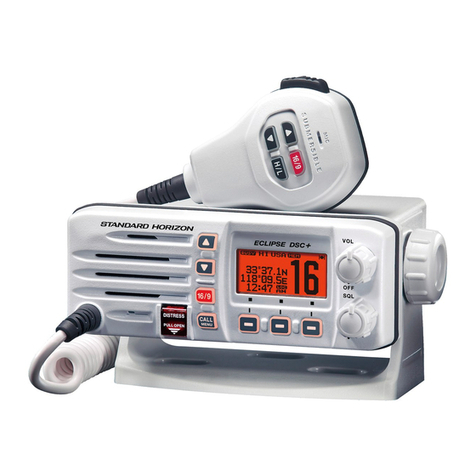
Standard Horizon
Standard Horizon ECLIPSE DSC+ GX1200E owner's manual
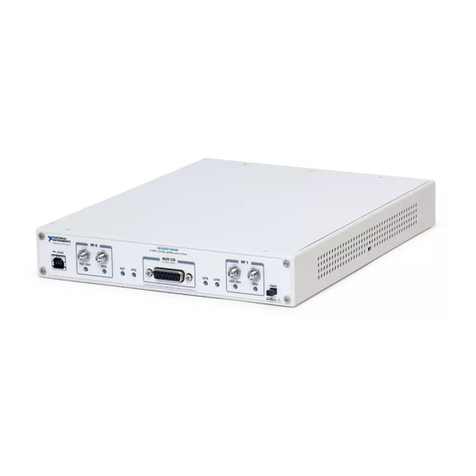
National Instruments
National Instruments USRP-2950 Getting started guide
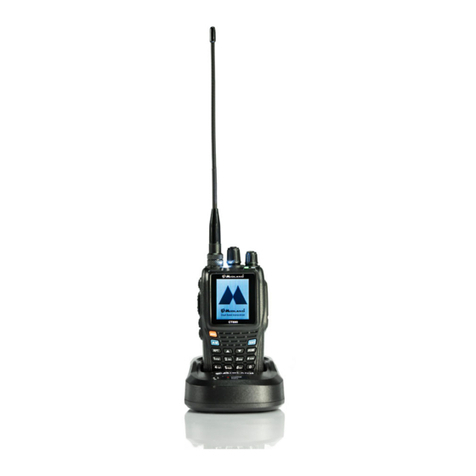
Midland
Midland CT 890 Instruction guide

Kenwood
Kenwood TS-130SE instruction manual

Kenwood
Kenwood TK-285 Instruction manual and user handbook
